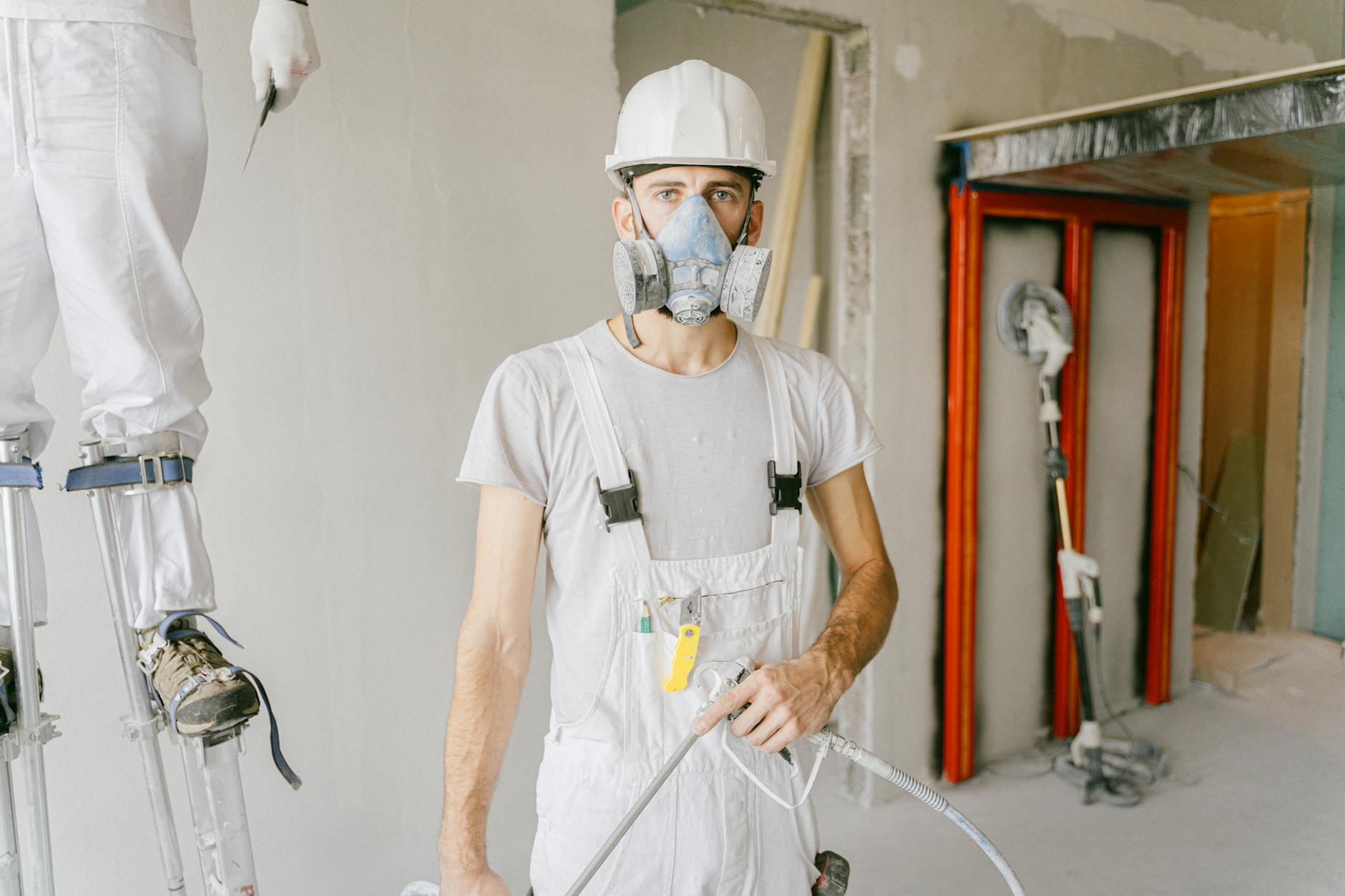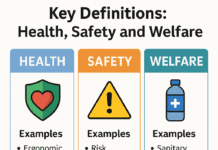
Painting Work Safety: Hazards and Control Measures
1. Introduction
Painting is a critical activity in various industries, including construction, oil & gas, and manufacturing. While it enhances aesthetics and provides protective coatings, it also involves significant hazards such as exposure to toxic chemicals, fire risks, and ergonomic strains. Proper safety measures must be implemented to protect workers and ensure compliance with occupational health and safety regulations.
This document outlines the hazards associated with painting work and the necessary control measures to mitigate risks.
2. Common Painting Activities
Painting work involves several key tasks, including:
- Surface Preparation: Sanding, scraping, priming, and filling cracks.
- Paint Application: Spraying, brushing, or rolling paints, varnishes, or coatings.
- Decorative Finishes: Stenciling, faux finishes, or wallpapering.
- Cleaning & Maintenance: Removing old paint, cleaning surfaces, and maintaining painted structures.
Each of these activities presents unique hazards that must be managed effectively.
3. Hazards in Painting Work
A. Chemical Hazards
Workers are exposed to hazardous chemicals in paints, solvents, and surface preparation materials.
1. Solvents and Paints
- Volatile Organic Compounds (VOCs): Found in paints, thinners, and cleaners, causing dizziness, headaches, and long-term organ damage.
- Isocyanates (in Polyurethane Paints): Can cause asthma, skin irritation, and respiratory issues.
- Heavy Metals (Lead, Chromium): Present in older paints, leading to poisoning and neurological damage.
2. Dust and Fumes
- Sanding and Grinding: Releases toxic dust (lead, silica) that can cause lung diseases.
- Spray Painting: Produces airborne particles that can be inhaled.
B. Physical Hazards
1. Slips, Trips, and Falls
- Wet or slippery surfaces from spilled paint.
- Working on ladders, scaffolds, or elevated platforms.
2. Noise Exposure
- Sanding, grinding, and spray equipment generate high noise levels, leading to hearing loss.
3. Eye and Skin Injuries
- Paint splashes, chemical burns, or debris during surface preparation.
C. Ergonomic Hazards
- Repetitive Motions: Brushing, rolling, or sanding for long periods causes muscle strain.
- Awkward Postures: Working overhead or in confined spaces leads to back injuries.
D. Fire and Explosion Hazards
- Flammable Liquids: Paints, thinners, and solvents are highly combustible.
- Static Electricity: Spray painting can generate sparks, igniting fumes.
E. Environmental Hazards
- Improper Waste Disposal: Spills and discarded paint can contaminate soil and water.
- Air Pollution: VOC emissions contribute to smog and respiratory problems.
4. Control Measures for Painting Hazards
A. Personal Protective Equipment (PPE)
- Respiratory Protection:
- Use NIOSH-approved respirators (N95, half/full-face masks) for dust and fumes.
- Supplied-air respirators for high VOC exposure.
- Skin Protection:
- Chemical-resistant gloves (nitrile, neoprene).
- Coveralls to prevent skin contact.
- Eye Protection:
- Safety goggles or face shields to prevent splashes.
- Hearing Protection:
- Earplugs or earmuffs in high-noise areas.
- Fall Protection:
- Harnesses and lifelines when working at heights.
B. Engineering Controls
- Ventilation Systems:
- Local Exhaust Ventilation (LEV) to remove fumes.
- Dilution Ventilation in enclosed spaces.
- Spray Booths:
- Enclosed booths with proper airflow to capture overspray.
- Automated Equipment:
- Use robotic sprayers to reduce manual exposure.
C. Administrative Controls
- Training & Awareness:
- Hazard communication (HazCom) training on chemical safety.
- Safe handling of flammable materials.
- Work Rotation:
- Limit exposure time to reduce chemical inhalation risks.
- Proper Waste Management:
- Store and dispose of paint waste according to EPA/OSHA regulations.
D. Safe Work Practices
- Surface Preparation Safety:
- Use wet methods to reduce dust when sanding.
- HEPA-filter vacuums for lead or silica dust cleanup.
- Paint Application Safety:
- Avoid open flames near flammable paints.
- Use anti-static equipment for spray painting.
- Confined Space Entry:
- Test air quality for oxygen levels and toxic gases.
- Use buddy system and permits for entry.
- Emergency Preparedness:
- Keep fire extinguishers (Class B) nearby.
- Provide eye wash stations and emergency showers.
5. Conclusion
Painting work involves multiple hazards, including chemical exposure, fire risks, and physical injuries. Implementing PPE, engineering controls, administrative measures, and safe work practices is essential to protect workers. Employers must ensure compliance with OSHA, NIOSH, and EPA regulations to maintain a safe working environment.
By following these guidelines, industries can minimize risks and ensure the health and safety of painting personnel.
Demolition Safety: Hazards and Control Measures
Chemical Safety & Hazard Communication (GHS, SDS)
Manufacturing Safety: Machine Guarding & Lockout-Tagout (LOTO)
National Fire Service Day 2025: History, Significance, and Key Facts
How to Implement Behavior-Based Safety (BBS) – 10 Key Questions
6. FAQs on Painting Safety
FAQ 1: What are the most dangerous chemicals in painting work?
Answer:
The most hazardous chemicals in painting include:
- Volatile Organic Compounds (VOCs): Found in paints, thinners, and solvents; cause dizziness, headaches, and long-term organ damage.
- Isocyanates (in polyurethane paints): Can trigger asthma, skin irritation, and severe respiratory issues.
- Heavy metals (lead, chromium, cadmium): Present in old paints; cause neurological damage and poisoning.
- Solvents (xylene, toluene, acetone): Flammable and toxic upon inhalation or skin contact.
Safety Tip: Always check Safety Data Sheets (SDS) for chemical hazards and use proper PPE (respirators, gloves, goggles).
FAQ 2: How can workers protect themselves from paint fumes?
Answer:
- Use proper ventilation: Work in well-ventilated areas or use Local Exhaust Ventilation (LEV).
- Wear respirators:
- N95 masks for dust.
- Half/full-face respirators with organic vapor cartridges for solvents.
- Supplied-air respirators (SARs) in confined spaces.
- Take breaks: Rotate workers to limit exposure time.
- Avoid eating/drinking near painting areas to prevent ingestion.
FAQ 3: What PPE is required for spray painting?
Answer:
- Respiratory Protection: NIOSH-approved respirator with appropriate filters.
- Eye Protection: Goggles or face shield to prevent splashes.
- Skin Protection: Chemical-resistant gloves (nitrile/neoprene) and coveralls.
- Hearing Protection: Earplugs/muffs if using loud equipment.
- Fire-resistant clothing if working with flammable paints.
Additional Safety: Use anti-static spray guns to prevent sparks.
FAQ 4: How should old lead-based paint be handled safely?
Answer:
- Test for lead before sanding/scraping (EPA-approved kits).
- Wet methods: Mist surfaces before sanding to reduce dust.
- HEPA vacuum cleaners: Use for cleanup instead of dry sweeping.
- PPE: Wear a P100 respirator, disposable coveralls, and gloves.
- Disposal: Follow EPA hazardous waste regulations for lead paint debris.
Legal Requirement: OSHA’s Lead in Construction Standard (29 CFR 1926.62) applies.
FAQ 5: What are the fire hazards in painting work?
Answer:
- Flammable liquids (paints, thinners, solvents) can ignite from:
- Open flames (welding, smoking).
- Electrical sparks (ungrounded equipment).
- Static electricity (spray painting).
- Dust explosions from accumulated paint powder.
Prevention:
- No smoking in painting areas.
- Ground all equipment to prevent static sparks.
- Store flammables in approved safety cabinets.
- Keep fire extinguishers (Class B: flammable liquids) nearby.
FAQ 6: What should be done in case of paint chemical exposure?
Answer:
- Inhalation: Move to fresh air immediately; seek medical help if breathing difficulty occurs.
- Skin Contact: Wash with soap and water; remove contaminated clothing.
- Eye Contact: Flush with water for 15 minutes; seek medical attention.
- Ingestion: Do NOT induce vomiting; call poison control (1-800-222-1222 in the US).
Emergency Preparedness: Always have eyewash stations and emergency showers in painting zones.
FAQ 7: How can ergonomic injuries in painting be prevented?
Answer:
- Use extension poles for rollers to avoid overreaching.
- Take frequent breaks to prevent muscle strain.
- Rotate tasks to avoid repetitive motions.
- Use ladders/scaffolds properly to prevent falls.
- Wear supportive footwear for long standing hours.
FAQ 8: What are the environmental risks of painting, and how to minimize them?
Answer:
- Air pollution from VOC emissions.
- Water contamination from paint spills/thinner disposal.
- Soil pollution from improper waste dumping.
Control Measures:
- Use low-VOC or water-based paints.
- Collect and recycle paint waste per EPA guidelines.
- Avoid washing paint tools in storm drains.
- Use spill containment kits for accidental leaks.
FAQ 9: Is confined space painting hazardous? What precautions are needed?
Answer:
Yes, confined spaces (tanks, vessels, pipelines) pose high risks:
- Oxygen deficiency from paint fumes.
- Explosion hazards from flammable vapors.
- Difficulty in rescue operations.
Safety Steps:
- Test air quality (O₂, LEL, VOCs) before entry.
- Use forced-air ventilation.
- Wear a supplied-air respirator.
- Follow permit-required confined space procedures (OSHA 1910.146).
- Use a buddy system with continuous monitoring.
FAQ 10: What training should painting workers receive?
Answer:
Workers must be trained on:
- Hazard Communication (HazCom/GHS): Understanding SDS and chemical labels.
- PPE Usage: Proper selection and maintenance.
- Fire Safety: Handling flammable materials and emergency response.
- Fall Protection: Safe ladder/scaffold use.
- Lead/Asbestos Awareness: If working in older buildings.
Regulatory Compliance: OSHA mandates annual refresher training for hazardous operations.

























Tell me about the primer hazards and precaution measurements